This page highlights the cross at Boho, in County Fermanagh. It includes an Introduction to the Site, and The Saint, and a description of the Images on the Cross.
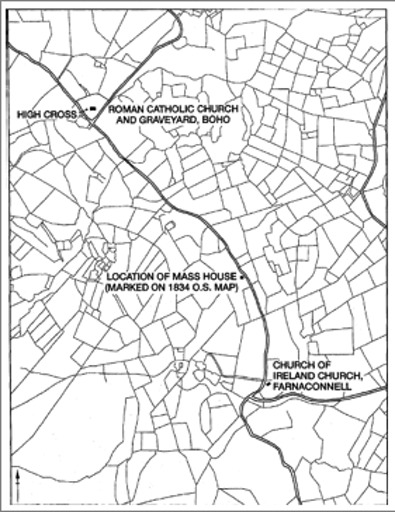
Introduction to the Site
The Boho High Cross is located in the graveyard behind the Roman Catholic Church of the Sacred Heart at Boho. Boho is located west of Enniskillen and is signposted from the A4. It can also be reached by taking the B81 west from Enniskillen. The distance is about 10 miles. The map to the right was prepared by a team of archeologists who conducted an excavation of the cross in 2002. (Donnelly, 2003, p. 122)
The ecclesiastic site at Boho has been in use since the Early Christian period. It is presumed that it was the site of a monastery or nunnery. (Donnelly, 2002, p. 4) There are at least two pieces of evidence that point in that direction.
First, the presence at Boho of a High Cross suggests this was an ecclesiastical site. It also indicates that the foundation was relatively prosperous when the cross was erected. The dating of the cross is a subject of some debate. Francoise Henry, based on similarities to the Drumcliff Cross, County Sligo, suggested a date for the Boho Cross in the 11th century. (Harbison, 1992, p. 374) Peter Harbison suggested that it belongs instead to the 9th century due to similarities with the Cross of Saints Patrick and Columba at Kells, County Meath (Ibid, p. 372) and to the Drumcliff Cross, County Sligo, which he gives an earlier date than Francoise Henry. (Ibid, p. 375) This does not, however, give us a date for the establishment of the monastery or nunnery which we can assume must have been 9th century at the latest.
Second, Church lands continued to exist at Boho in the 15th century, in the form of a parish church, as indicated by a reference in the Annals of Ulster to the presence in 1483 of an erenagh. (Donnelly, p. 4) The erenagh was an officer in the medieval period who was responsible for receiving parish revenue, overseeing parish land and building and maintaining church property.
The earliest reference to the High Cross belongs to 1834, when Captain Alexander Henderson reported in the Ordnance Survey Memoirs for the parish that: ‘in the townland of Toneel near the site of an old monastic building there is a stone about 5 feet high and about 1 foot and a half by 6 inches, rudely carved on each side, but the figures, though in tolerable good relief, are not sufficiently characterised to warrant anything more than conjecture as to whom they were intended to represent’”. (Donnelly, 2002, p. 5)

The Boho cross is one of only a few to be excavated in Ireland and the first in Ulster. (Donnelly, 2003, p. 129) This excavation indicated that the cross has probably been moved from its original position. This probably occured in the early 1800’s when the new church was constructed. “It is probable that this construction process would have disturbed human remains. It is also reasonalbe to suggest that the workers may have encountered pieces of a collapsed high cross -- its foundation slab, socketed base and shaft -- during their work. It is worth noting that local folk-lore relates how the high cross arrived in Boho ‘overnight’ (John Curran pers comm). It can be suggested, therefore, that a new location was reqired for the newly discovered cross and that the highest point in the graveyard was deemed appropriate, to the west of the new church. A pit was excavated and the bones and coffin pieces disturbed by the building work were gathered togeter and placed into it. This charnal pit was then covered with a mixed graveyard soil and the high cross was re-erected on top.” (Donnelly, 2003, p. 130)
The Saint
Saint Faber (Feadhbar) is patron saint of the Sacred Heart Church in Boho. Whether she founded a monastery or nunnery there or whether it was later dedicated to her is not known. She is mentioned in The Martyrology of Oengus the Culdee, written about the beginning of the 9th century as “Fedbair a virgin of Botha.” (The Martyrology of Oengus the Culdee, London: Henry Bradshaw Society, 1905, pp. 240-241)
The stained glass window to the left depicts St. Faber and her pet deer. The window is located in the Sacred Heart Church, Boho. The source of the photo is: http://en.wikipedia.org/wiki/Saint_Faber (10/2013).
Images on the Cross
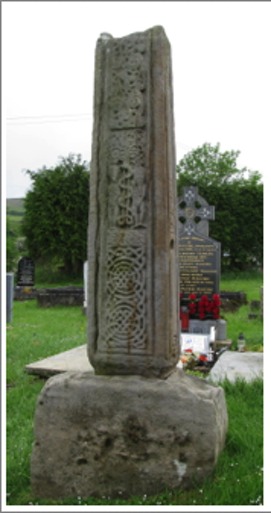
A general examination of the cross reveals the following information. The shaft of the cross is 1.88 m high. There is roll moulding with a narrower moulding inside it on the edges of the cross. The panels of the cross are not clearly divided as is frequently the case on other high crosses. On each of the sides there is a hole located about 60 cm up the shaft. It is presumed this would have held a tie-piece connected in turn to a vertical strut that would have supported the arms of the cross. Similar holes are found on the Drumcliff Cross in County Sligo which is closely related to the Boho cross by its iconography. (Harbison, 1992, p. 28)
Following an excavation in 2002 to straighten the cross, it was found that the base is 0.80 metres high, 0.97 metres (north-south) by 0.77metres (east-west). (Donnelly, p. 10) These measurements increased the previously known height of the base by some 18 cm. (See Harbison, 1992, p. 28)
East Face
The east face of the cross is seen in the photo to the right.
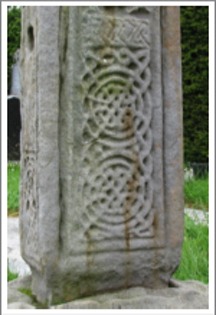
The lower portion of the shaft (left) contains interlace. The interlace begins with two circular patterns linked together by lines of the interlace and crowned by a simple two-strand interlace pattern.
Above the interlace design is a small band of fret pattern.
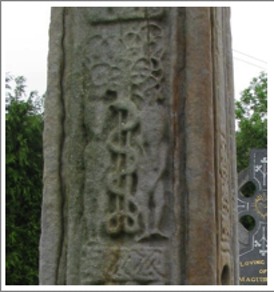
The center section of the shaft (right) contains an image of Adam and Eve. It is a depiction of part of the story of The Fall told in Genesis chapter three. In this scene, Adam and Eve stand under a tree that has a double stem. The tree spreads out above them. The left hand figure is Eve and the right hand figure is Adam, who is sporting a beard. Each of them, with one hand, covers their nakedness. This places the scene after the eating of the forbidden fruit, when they knew they were naked. (Genesis 3:7) Eve appears to stretch out her right hand to Adam. Adam appears to have his right hand up beside his cheek. The serpent winds its way up the tree and faces Eve. (Harbison, 1992, pp. 28-29)
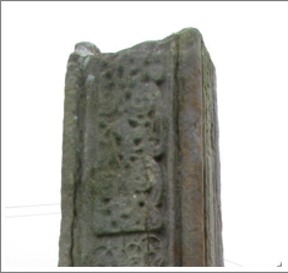
The upper portion of the shaft (left) is decorated with “irregular spiral motifs.” (Harbison, 1992, p. 29)
South Side
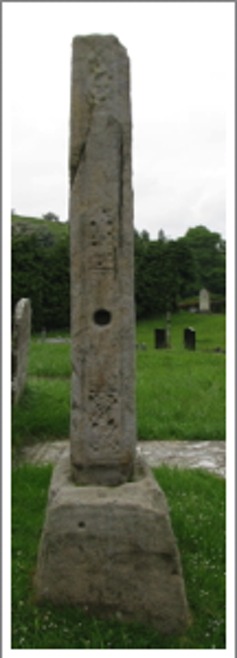
The south side of the cross shaft (right) is partly decorated. Beginning at the bottom, there is interlace in the form of two circular devices. The second panel is undecorated It contains a hole, the purpose of which is described above. The third panel is in disrepair but appears to be composed of interlace. The fourth panel up is undecorated. The fifth panel contains badly worn interlace.
West Face
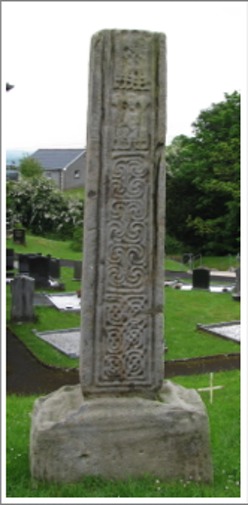
The west face of the cross is pictured to the left.
The bottom panel (below left) consists of interlace similar to that on the east face, lower shaft. In this case the pattern contains six spiral devices rather than two. They are interconnected.
The second panel (below right) contains “pelta-shaped curves” that are interlinked. In the spaces left along the edges there are small bosses. The clearest of these can be seen in the lower right of the image below. (Harbison, 1992, p. 29) Pelta is the Greek for shield. There is a class of pelta-shaped shields that are elliptical in shape.
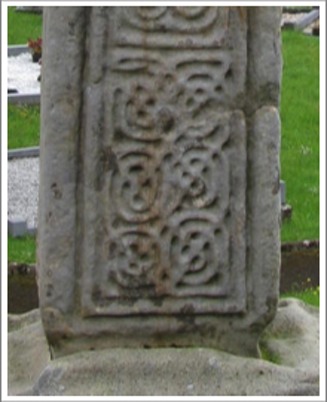
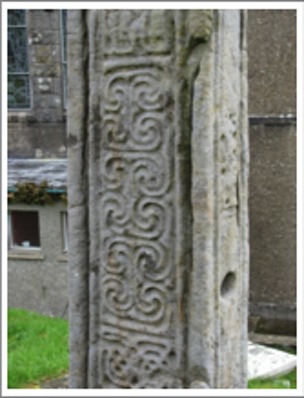
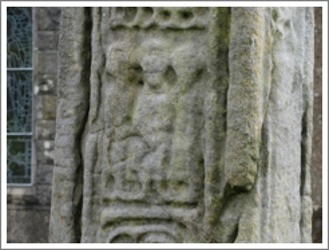
The third panel (left) has been interpreted as depicting the Presentation of John the Baptist in the Temple. (Lk 1:59) The figure in the center of the panel is taken to be Elizabeth, the mother of John. She is seen to hold a child in front of her. While the figures on either side are not identified by Harbison, they may be taken as Zechariah, John’s father, and another priest of the temple.
Though the scene above this (below right) represents the baptism of Jesus, this image is not identified as the presentation of Jesus. (Lk:2: 21-32) In part this is due to the positioning of the Mary figure. In most images of the presentation of Jesus, Mary and Simeon are both shown in profile. (Harbison, 1992, p. 236-7)
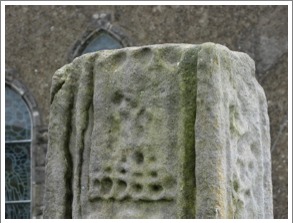
The fourth panel (right) represents the Baptism of Jesus. (Mt. 3:13-17) There are three figures. Christ stands in the center and faces John the Baptist on the right. John appears to stretch out a hand toward Jesus. The figure behind Jesus may be an angel and it is possible there is a dove above Christ’s head to represent the Holy Spirit. The pattern at the bottom of the panel represents the River Jordan, where Jesus was baptised. (Harbison, 1992, p. 29)
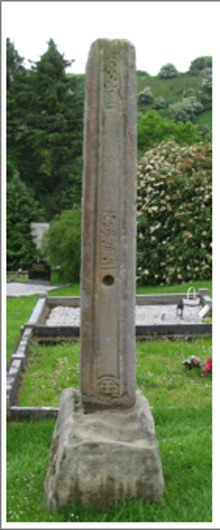
North Side
The north side of the cross (left), like the south side is partly decorated. At the bottom of the shaft there is a small circular pattern of interlace. The second panel is undecorated and like the south side, contains a hole. The third panel is interlace. The fourth panel is undecorated. The fifth panel is interlace.
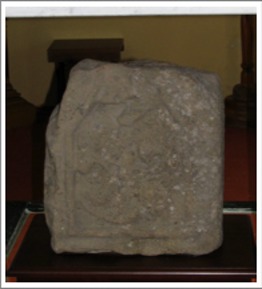
Arm Fragment
Located in the church under the pulpit is a fragment of a cross arm (right) that was found near the base of the cross. Similarities with the moulding pattern on the edges of the cross shaft make it probable the arm belongs to the cross. On one face (not illustrated) whatever pattern there may have been has worn off. On the other side (right) there is what appears to be interlinked bosses from which small animal-heads emerge.” (Harbison, 1992, p. 29) Obviously most of the head of the cross is missing and the arm fragment shows no sign of a ring.
Resources Cited
Donnelly, Colm; Macdonald, Phillip; Murphy, Eileen; and Beer, Ncholas; Excavations at Boho High Cross, Co. Fermanagh, Data Structure Report: Boho High Cross, Toneel North, Co. Fermanagh, 2002.
Donnelly, Colm; Macdonald, Phillip; Murphy, Eileen; and Beer, Ncholas; Excavations at Boho High Cross, Toneel North, County Fermanagh, Ulster Journal of Archaeology, Third Series, Vol. 62, (2003), pp. 121-142.
Harbison, Peter; The High Crosses of Ireland: An Iconographical and Photographic Survey, Dr. Rudolf Habelt GMBH, Bonn, 1992. Volume 1: Text, Volume 2: Photographic Survey; Volume 3: Illustrations of Comparative Iconography.
The Martyrology of Oengus the Culdee, London: Henry Bradshaw Society, 1905, pp. 240-241.
Photo found at: http://en.wikipedia.org/wiki/Saint_Faber